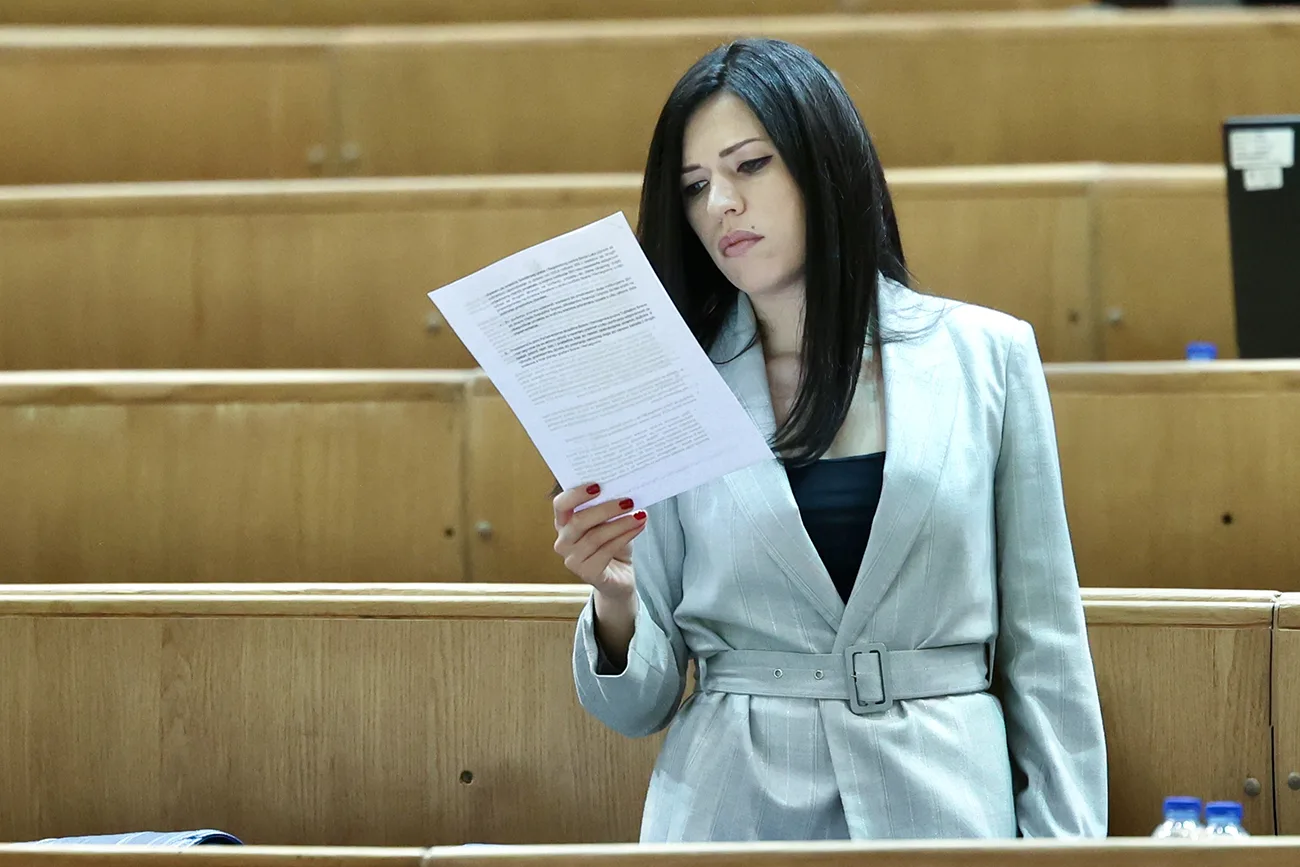Bosnian Filmmakers Are Without a Film Industry
When director Danis Tanović’s “No Man’s Land” won the Academy Award for best foreign film in 2002, it may have been a celebration of Bosnian artistry but to many BiH filmmakers it could not represent a triumph of the country’s film industry.
That is simply because Bosnia and Herzegovina does not have one, according to local producers and directors.
Don't want to miss our stories?
Sign up for our newsletter.
Don't want to miss our stories?
Sign up for our newsletter.
Despite the fact that in one night, the film put the country of BiH on the map for most of the world, nothing about the film, other than the story, one star actor and the director’s heritage, came from BiH.
The film was financed by Western European and Slovenian money, filmed in Slovenia to avoid BiH bureaucracy, with Slovenian cameras and equipment unavailable in BiH, and by a director, Tanović, who has lived in Belgium since 1994.
And nothing has really changed since Tanović’s 2002 success, filmmakers added.
“We do not even have a Ministry of Culture at the state level,” film director Dino Mustafić said bitterly. “We have Bosnian movies, Bosnian screenwriters, but not a Bosnian (film) industry.”
A local film industry is still a dream to many of the BiH directors like Mustafić, who are trying to recreate Tanović’s success. Many are asking if the government is doing enough to support the building of an industry that could be a major economic help to the country as well as a source of pride in its post-war future.
One film business scholar said that with the kind of government support that exists in neighboring countries, BiH’s wealth of directorial talent could produce an industry more successful than Croatia’s or Serbia and Montenegro’s.
In an inquiry into BiH’s investment in its cultural assets, a team of eight reporters from Sarajevo’s Center for Investigative Reporting, found that cultural assets in BiH, from buried ancient towns to tourist sites from the last war — and an international film reputation — represent money waiting to be made. But government officials and business leaders all too often do not seem to recognize the potential, particularly when compared to the support of the same industries in neighboring countries.
A lack of local funding means that BiH producers have to find a greater percentage of production money from abroad, and a lack of support facilities means they will pay a good deal of the film’s budget to regional film industries.
Meanwhile, the usual divisive politics between BiH’s two entities has left Republika Srpska with practically no filmmaking at all, except for student films (See sidebar “Dreaming RS Movies”).
Many of the emerging countries in Eastern Europe have used national film production to begin building studios and production facilities to attract film companies from around the world, and the millions of KM in their production and post-production budgets. Meanwhile, BiH’s only pre-war studio, Sutjeska Film, lies in postwar ruins in Sarajevo, littered with reels of film and rotting historical costumes.
“In 2004 only, more than one million marks went abroad for post-production on four (of our) feature films” said Ismet Begtašević, executive producer at Refresh Productions in Sarajevo.
When Tanović went looking for financing for “No Man’s Land” in 1999, the FBiH Minister for Culture and Education had little help and no money to offer.
“Regretfully, I gave him recommendations which helped him obtain the support of foreign producers for the filming of his movie,” former minister Fahrudin Rizvanbegović said.
French investors provided over half of “No Man’s Land’s” 4.4 million KM budget with the rest of the financing coming from Italy, Belgium, Great Britain, and Slovenia, according to one of the film’s producers, Dunja Klemenc, from Slovenia’s Viba Film.
Tanović’s success with “No Man’s Land” did bring a change in the BiH government’s attitude, if not much of a financial change, filmmakers agreed.
Two years ago FBiH established a film fund, similar to film funds in other countries in the region, to provide initial financing that filmmakers could use to find private investment for their productions.
But filmmakers complain that the fund financing is too little, and there has been no progress at all on creating the kind of industry infrastructure that could bring in major foreign productions.
The 1.5 million KM budgeted each year by the fund, Sarajevo Foundation for Cinematography, for film financing, in comparison to the 5 million and 6 million KM, respectively, spent by Croatia and Romania last year, looks more like social welfare than financial promotion, BiH filmmakers and even government officials agreed.
In the two years of the FBiH fund’s existence, it spent 1.9 million KM to provide initial funding for 14 feature films. The fund financing amounted to approximately 20 percent of the films’ total production budgets, according to some directors.
In 2004, Pjer Žalica, the award-winning director, received 300,000 KM for “Kod amidže Idriza” (“At Uncle Idriz’s”).
“That means that the government participated in the making of this movie with only 10 percent of the 3 million KM budget,” Žalica said.
While the directors might like better the Romanian support, which averaged 600-700,000 KM per film last year, 10 to 20 percent financing is considered sufficient to attract critical foreign financing, which most countries’ film industries must depend on, according to producer Klemenc.
But Nikola Kovač, the President of the FBiH fund’s executive board, agreed with filmmakers that the financial means provided for movies are insufficient.
“For now we can support projects with some kind of welfare,” Kovač said. “A little bit for everyone.”
The strategy of the fund promises to provide more money as successful films pay back the money within three years, and the fund builds capital, Kovač added. There have been no repayments yet because the fund is only two years old, he added.
But the economics of filmmaking often suggest that films will never “make money” on paper.
Žalica for one said his films will not be able to pay back the fund anything because there isn’t enough audience support in the BiH market to turn a profit.
For example, Žalica’s “At Uncle Idriz’s” one of the most successful Bosnian films, had an audience of only 120,000, according to Begtašević, from Refresh Productions, which produced the film. At an average price of 2.5 KM a ticket the film has only produced 300,000 KM gross so far, Begtašević added.
There is not much hope that foreign sales will help either, particularly within the film fund’s three-year pay back period. On Žalica’s 2002 “Gori Vatra,” (“Fuse”) Refresh has only recently received 40,000 KM in its share of foreign revenue, which had to go back to the foreign distributor to pay for film prints, Begtašević said.
Romanian independent producers interviewed by the CIN team would not reveal how much their films made, they said, because they do not declare the income to avoid taxes.
“No Man’s Land” did not earn a single KM in profit, according to Dunja Klemenc, whose Slovenian production company, Viba Film, put up 400,000 KM of the 4.4 million KM cost.
The company was able to return only 90 percent of the investment but the indirect effects of the production helped to build Viba as part of a film industry.
“The film’s notoriety brought new clients to “Viba Film,” said Klemenc.
The studio got lucrative post production jobs for film developing, editing and other services from new customers in France, Italy and Germany, Klemenc said.
Miran Zupanič, the dean of the Art, Film and Theatre Academy in Ljubljana, Slovenia, agrees that the real value of a national film industry is not in the “profits” from films. There are other benefits both immaterial and financial, Zupanič said.
A national film industry is a way to market the whole country to the world, Zupanič added. This could be said of American films, and also those of the former Yugoslavia.
“The (Yugoslavian) state was investing in movies and the film industry, not because they loved the movies,” Zupanič said, “but because they were well aware of the effects a film can produce when presenting the country in the world.”
Slovenia learned the lesson, Zupanič added.
“Slovenia realized that without a film industry, there were no good films, or new jobs,” Zupanič said.
In addition to helping finance films with seven million KM last year, the Slovenian Ministry of Culture spent an equal amount on helping to build the industry infrastructure. Another seven million was invested in a film laboratory and Viba Film, the state company that has two studios, Zupanič said.
But BiH did not learn from the success of “No Man’s Land,” Zupanič and BiH filmmakers agreed.
When Tanović started making “No Man’s Land,” he faced a financial and bureaucratic nightmare in the country he later thanked from the Academy Awards stage.
He turned to Slovenia’s film industry to make his film.
“We should not be surprised that Tanović made his movie “No Man’s Land” in Slovenia,” said director Mustafić. “He hired foreign actors and workers. All that was a lot cheaper then it would have been in our country.” (Bosnian star Branko “Ðuro” Ðurić was also in the film.)
Tanović confirmed the problems.
“It would have been easier to move BiH to Slovenia then to make the movie in Bosnia,” he said.
To film his movie Tanović needed to ask for approvals and permissions from numerous ministries which raised costs and frustrations.
Most film industries are promoted by both a film fund and a film board. The film board is there to smooth the permit process and help filmmakers find the services they need.
But in BiH there is no film board and there are no studios, no camera rentals, none of the services to support filmmaking.
BiH filmmakers are all the more frustrated, they said, because there is no reason why their country should not be as successful a film center as any of the surrounding countries.
“We have beautiful sceneries, a rich history, and all that could be used to make money”, said Ademir Kenović, the producer of Žalica’s “Gori vatra” (“Fuse”) and director of films like “Ovo malo duše” (“So Little Soul”) and “Kuduz.”
All that’s needed, Kenović added, is the infrastructure that filmmakers and production companies need to make films economically.
Begtašević, the executive producer of Sarajevo’s Refresh Productions, said that film industry infrastructure could generate employment of local persons as well as create more new skilled jobs. Additional income could come from the rental of film equipment, Begtašević added.
The hottest film industry in Eastern Europe, in Romania, could illustrate Begtašević’s point.
Romania is making millions from foreign productions that are saving money by filming there. There are 20 film studios all built with private funding.
Two studios, Kastel and Media Propicture, cater to large Hollywood and European productions. Propicture reportedly received more than $20 million alone from three Western productions in 2003. Kastel brought in $30 million to the local economy from the Hollywood production of “Cold Mountain,” starring Nicole Kidman.
With the same kind of investment as Romania or Slovenia, BiH could have the leading film industry in this part of the Balkans, Zupanič said.
“It is necessary for the politics and the politicians to finally realize that BiH could be much better presented to the world through movies,” Zupanič said.
In Sarajevo the only symbol of Bosnia’s nascent pre-war film industry, is now a bombed out shell of its former self. The Sutjeska Film Studio used to be a center of documentary filmmaking, and it earned income from renting out its studio space, props and large historical costume collection to filmmakers.
Now only the old brick walls of the Sutjeska building are left standing. The studio’s archive of old Yugoslavian films is spread over the ground in the snow inside the doorway.
Even before the war, it was not a typical studio, Žalica remembers. He remembers no cameras and no lighting available in the studio.
“Nevertheless, this studio had a large collection of historical costumes and other historical items,” Žalica said sadly. “Now it is all destroyed and falling apart.”
A call to the number listed for Sutjeska in the phone book is answered only by a watchman.
“They have a director,” the watchman said on the fifth attempt to contact the company. “But you can never find where the guy is.”
























